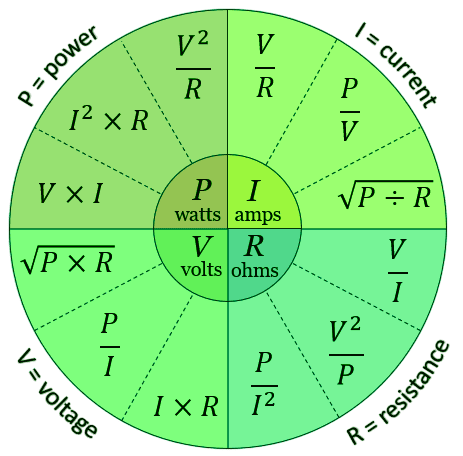Ohm's Law Calculator
Calculate Voltage, Current, Resistance, and Power in Seconds
📋How to Use the Ohm's Law Calculator?
-
Choose which parameter you will calculate (voltage, current, or resistance).
-
Enter the known values using the appropriate units (volts, amps, ohms).
-
Select Click "Calculate" to receive the results utilizing Ohm's Law
This tool allows you to solve for any of the four variables in a basic DC circuit: Voltage (V), Current (I), Resistance (R), and Power (P). Simply enter any two known values and the tool will compute the others using the formulas V = I \times R and P = V \times I.
Be sure to pay attention to units (e.g., Milliamps vs. Amps). This calculator is a favorite for students, DIY electronics hobbyists, and professional electrical engineers for rapid circuit prototyping and troubleshooting.
Useful Tips💡
-
Always check if your current is in Amps or Milliamps (1A = 1000mA).
-
For AC circuits, Ohm's Law only applies to purely resistive loads (for inductive/capacitive loads, use impedance).
Mistakes to Avoid ⚠️
- Using Milliamps (mA) in the formula without converting to Amps (A), leading to results 1000x too large.
- Confusing Power (Watts) with Current (Amps).
- Forgetting that resistance in a wire increases with heat, which can change your results in high-power applications.
How Calculations Are Performed?
The Ohms Law calculator works using the equation V=IR, where V =voltage in volts, I =current in amps, and R =resistance in ohms. You have to set the current, I=V/R, or the resistance, R=V/I. If you're calculating power, you can use P=VI or P=I²R.
These equations were developed by Georg Ohm and are the standard in the electrical engineering industry, and the Institute of Electrical through Electronics Engineers (IEEE) has validated the accuracy of these equations to be used in DC circuit analysis.

Practical Applications📊
-
Determine voltage drop to safely choose circuit components.
-
Determine current flow supply the power required by the components.
-
Assess resistance values to optimize circuit performance and energy efficiency.
Questions and Answers
What is an Ohm's Law calculator?
An Ohms calculator is a tool that can solve voltage, current, or resistance values using the equation V=IR. You simply need to input two known values, such as voltage and resistance, and it will instantly calculate the third value for you. This is useful in circuit analysis for DC circuits for engineers students and hobbyists, the goal of which is to efficiently design, build, and troubleshoot electrical systems. As long as you use the proper units and the calculator you are using is accurate, like CalcMate, you can use Ohm’s law to get accurate in everything you do in electronics and electrical engineering.
What is the Ohm's Law triangle?
It is a visual mnemonic where V is on top, and I and R are at the bottom. To find one, you cover it with your finger: V=IR, I=V/R, R=V/I.
Can I calculate Power (Watts) here?
Yes! Enter any two values (like Voltage and Current) and the calculator will automatically provide the Power in Watts.
What is resistance?
Resistance is the opposition to the flow of electric current, measured in Ohms (Ω). High resistance means less current flows for a given voltage.
Is Ohm's Law used for AC or DC?
It is primarily used for DC. In AC circuits, you must account for "Impedance" (Z), though the logic remains similar (V=IZ).
How accurate is the Ohms Law calculator?
The Ohms Law calculator is very accurate for DC circuits when values and units are entered correctly. The calculator utilizes standard formulas ( V = IR , I = V / R , R = V / I , P = VI) that are recognized by the Institute of Electrical and Electronics Engineers (IEEE). To ensure accuracy, be mindful of your initial input values, and don't forget to double-check your units, such as volts, amps, and ohms. If it's regarding AC circuits or complex systems, it may take more than an Ohm's Law calc or needing to consult an electric professional.
What is the formula used in the Ohm's Law solver?
Our calc uses the fundamental formula V = IR meaning voltage (volts) = current (amps) times resistance (ohms). Also, for power, the calculator uses the equations P = VI or P = I²R. The equations derived from Georg Ohm's book in 1827 that form the basis of electrical engineering and have been validated by IEEE standards (Institute of Electrical and Electronics Engineers). Using the Ohm's law solver is easy because it can solve for that variable when two other variables are known, making it a great asset in circuit calculations and electrical analysis.


